#african-american artist
Explore tagged Tumblr posts
Text
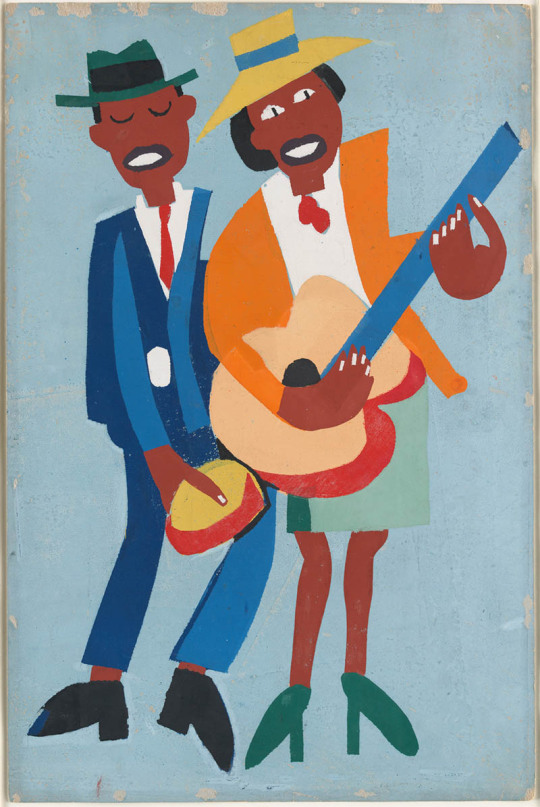
William H. Johnson, Blind Singer, ca. 1940. Screenprint with tempera additions.
Johnson was among the foremost painters of African-American life during the Harlem Renaissance. Born in South Carolina and educated in fine arts in New York and Provincetown, Johnson spent most of his time from the mid-1920s to the late 1930s in Europe, where he was influenced by Post-Impressionism and Expressionism. After achieving critical acclaim abroad, he returned to New York permanently in 1938 under the threat of war and with a desire to reconnect to his roots. The move produced a dramatic change in his work. Assigned by the government's Works Progress Administration to teach at the Harlem Community Art Center, Johnson became immersed in the sights, sounds, and people of New York's African-American community, which he captured in compositions of flat shapes, patterned designs, and brilliant colors that were distinctly modernist in their simplicity and directness.
During his lifetime, Johnson created more than seventy-five prints. While in Europe he produced woodcuts and linoleum cuts, usually with hand coloring, inspired by the raw power of German Expressionism. After returning to New York, he took up screenprint and pochoir, techniques that suited his new embrace of simplified forms and bold colors. He printed these works on assorted found papers and often completed his images by hand with tempera, making each print slightly different from the next. He frequently experimented with subjects by printing compositional variants and also rendering them in drawing and painting, each format enriching the other, but with the printed versions the most simplified of all.
Notable among Johnson's New York prints are those that capture the essence of Harlem's fashion, music, and dance. This print, entitled Blind Singer, shows a pair of musicians in an open-air performance that was common on the city's bustling streets. The composition's flatness, pure color, and orchestrated angularity endow this still image with a sense of rhythmic motion and dynamic energy. --Judy Hecker, in Deborah Wye, Artists and Prints: Masterworks from The Museum of Modern Art
Photo & text: MoMA
#vintage New York#1940s#William H. Johnson#painter#painting#Harlem Renaissance#Black painters#African-American artist#printmaker#vintage Harlem#Harlem culture
44 notes
·
View notes
Text

Sharon Barnes (African-American, lives and works in Los Angeles), (Ki Nu Ta Ben Vive Medu (That We Can Live Without Fear), 2024. Acrylic, oil, oil stick, burlap, paper, cardboard, thread on canvas 68 x48 in. | 152 cm x 121 cm. (Source: Patricia Sweetow Gallery, Los Angeles, CA.)
#Sharon Barnes#art#contemporary art#21st century art#abstract art#abstract expressionism#African-American art#African-American artist#Black art#Black artist#American art#American artist#LA art#LA artist#Los Angeles art#Los Angeles artist
9 notes
·
View notes
Text

MWW Artwork of the Day (2/18/25) Henry Ossawa Tanner (African-American, 1859-1937) Portrait of the Artist's Mother (1897) Oil on canvas, 74.3 x 100.4 cm. The Philadelphia Museum of Art
Henry Ossawa Tanner's portrait of his mother is both a tribute to Sarah Elizabeth Miller Tanner, the central, stabilizing figure in her large and distinguished African American family, and a celebration of her son's recent professional success. The painting also stands as a reminder of Tanner's success in his chosen career, in which he had persevered despite initial opposition from his parents. Tanner's portrait of his mother has none of the cool austerity of Whistler's picture, however. Instead it is an affectionate portrayal of a strong, sensitive, thoughtful personality.
3 notes
·
View notes
Text
Ralph Earl, “Houses Fronting New Milford Green”, circa 1796
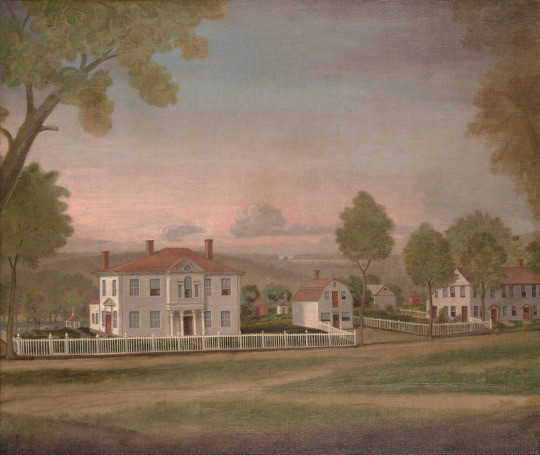
12 notes
·
View notes
Text
Barbara Jones-Hogu (1938-2017)
#bornOnThisDay Barbara Jones-Hogu (1938-2017) was an African-American artist best known for her work with the Organization of Black American Culture (OBAC) and for co-founding the artists' collective AfriCOBRA. Via Wikipedia #PalianSHOW
Barbara Jones-Hogu April 17, 1938 – November 14, 2017was an African-American artist best known for her work with the Organization of Black American Culture (OBAC) and for co-founding the artists’ collective AfriCOBRA. Via Wikipedia (photo) Jones-Hogu worked in a variety of printing techniques, including woodcuts, etchings, lithographs, and screen prints. Her work dealt directly with social and…
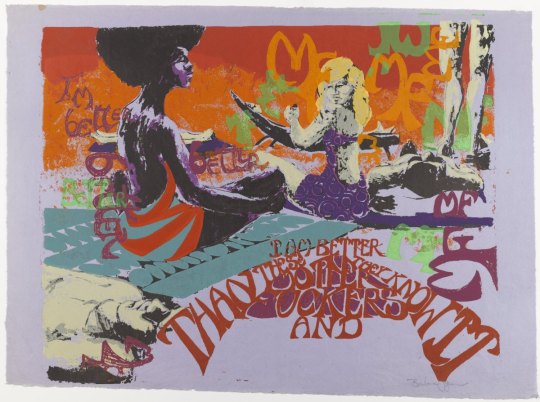
View On WordPress
#African-American#African-American artist#AfriCOBRA#Black American Culture#black artist#black herstory#blackartist#Brooklyn Museum#herstory#OBAC#unite
4 notes
·
View notes
Text
Kendrick Lamar uses power word kill!







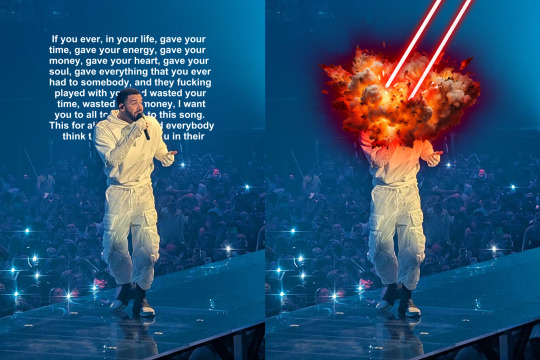
#this is probably old by now but it wouldn't leave my head until i made it#not fandom stuff#unless you're in the rap fandom then. well you get it#i don't even know if tumblr will appreciate this#putting a warning before people default to thinking i'm white and saying 'eugh but you have to understand the ~nuances~ of the rap beef'#⚠️the artist of this post is african american ⚠️#Kendrick lamar#Drake#super bowl#super bowl 2025#super bowl halftime show#not like us
681 notes
·
View notes
Text


The Original American Indians, the Black Indians.
#native americans#the original native americans#choctaw#black indians#indians#african women#black women#afro latinas#dark skin beauty#black queen#africa#black beauty#brownskin#black girl magic#chocolate beauty#melanin poppin#afro beats#afro latinos#caribbean#tropical#black#african#beautiful black women#artist#chocolate
417 notes
·
View notes
Text

Vanessa German —The Ordinary Sacred "Power Figure" (mixed media; wood, glass, found objects, 2015)
273 notes
·
View notes
Photo
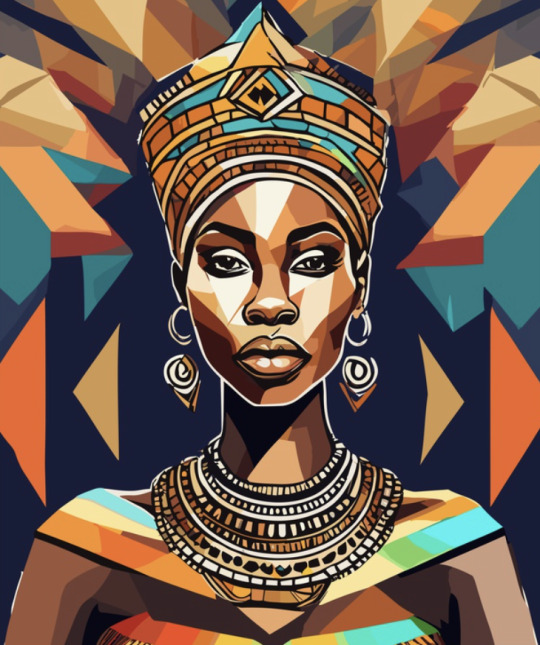
"African woman" by Judith Scholtz on INPRNT
#art#print#illustration#artist#judith scholtz#beautiful#geometric#cubism#artistic#black woman#artsy#african american#girl power#african woman#black pride#african queen#inprnt
2K notes
·
View notes
Text

Thomas Blackshear II, 'Beauty and The Beast', ''Spectrum'' #2, 1995
#Thomas Blackshear II#american artists#african-american artists#beauty and the beast#beauty & the beast#spectrum#color illustration
471 notes
·
View notes
Text
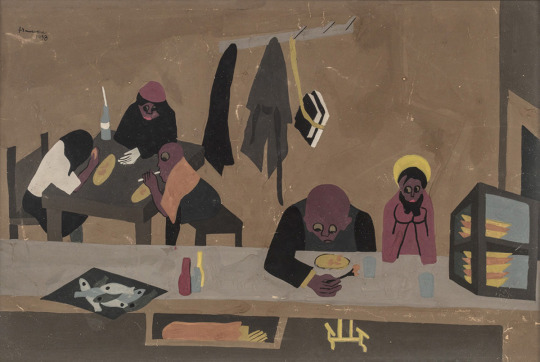
Jacob Lawrence, Harlem Diner, 1938. Water-pressed tempera on paper, laid on board.
Photo: NY Historical Society/Art Students League
#vintage New York#1930s#Jacob Lawrence#painting#Harlem Renaissance#Harlem Diner#tempera painting#Black artists#vintage Harlem#African-American artist
92 notes
·
View notes
Text

Alison Saar (American, b. 1956, lives and works in Los Angeles), Compton Nocturne, 2012. Three-colour lithograph, 25 1/8 × 19 1/8 in. | 63.8 × 48.6 cm.
#art#artwork#modern art#contemporary art#modern artwork#contemporary artwork#21st century art#21st century modern art#21st century contemporary art#American art#modern American art#contemporary American art#American artist#female American artist#female artist#woman artist#Black artist#African-American artist#LA artist#Los Angeles artist#California#Los Angeles#Compton#night#nocturne#California Dreaming#Made in LA#Alison Saar
21 notes
·
View notes
Text

MWW Artwork of the Day (2/23/25) Charles White (African-American, 1918–1979) Trenton Six (1949) Ink over graphite underdrawing on paperboard The Amon Carter Museum of American Art, Fort Worth TX
Charles Wilbert White was known for his WPA era murals. He was briefly married to famed sculptor and printmaker Elizabeth Catlett. The Trenton Six case arose in 1948 in Trenton, New Jersey, when six African American defendants were convicted by an all-white jury of the murder of an elderly white shopkeeper. On August 6, 1948 all six men were sentenced to death, even though they had been able to provide alibis, and had repudiated their prior confessions. The international attention focused on the case included many notables, from W.E.B. Du Bois to Pete Seeger -- even Albert Einstein.
4 notes
·
View notes
Text
Michael Jackson, with former girlfriend singer Stephanie Mills, receiving the 'Good Scout Humanitarian Award' from the Boy Scouts of America organization (1990).
#michael jackson#stephanie mills#boy scouts#1990#king of pop#mj#bad era#humanitarian#icon#legend#african american#black artists#black culture#black love#black women#black music#music#r&b#soul#pop#90s#rare#vintage#celebrity couple#moonwalker#award#video#sbrown82
171 notes
·
View notes
Text

Mars Dust, Alma Thomas, 1972
Acrylic on canvas 69 ¼ × 57 ⅛ in. (175.9 × 145.1 cm) Whitney Museum of American Art, New York City, NY, USA
#art#painting#alma thomas#contemporary art#abstract art#abstract expressionism#20th century art#20th century#1970s#black artists#women artists#acrylic#red#whitney museum#american#african american#artists of color#female artists#100 notes#250 notes
490 notes
·
View notes
Text

Winslow Homer (1836-1910) "A Flower to Teacher" (1875) Watercolor on paper Located in the Georgia Museum of Art, Athens, Georgia, United States
#painting#paintings#art#artwork#genre painting#male portrait#winslow homer#watercolor#watercolor on paper#watercolour#fine art#georgia museum of art#museum#art gallery#american artist#portrait of a boy#clothing#clothes#teachers#teacher#sunflower#sunflowers#monarch butterfly#african american#1870s#late 1800s#late 19th century#side profile
168 notes
·
View notes